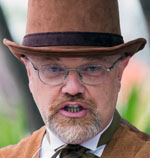By Eric George Tauber

CINCINNATI, Ohio — “Candidate X is soft on crime!”
We’ve all read that during an election cycle. But what they don’t say is who paid for this glossy paper junk mail? Why would experienced incumbent Republican lawmakers suddenly be the targets of vicious attack ads in normally quiet, local primaries? This is the subject of the documentary “Dark Money,” which I recently attended a screening of at the Cincinnati World Cinema.
“Montana is a microcosm of the national debate… ”
In Helena, Montana deer roam freely around the capitol and state legislators still work regular jobs like farming and teaching school, only serving in the legislature 90 days out of the year. The upside of this system is that politicians really stay in touch with their constituents, frequently passing them on the street. The downside is that they can write and strike down laws with their own business interests in mind. Case in point: American Tradition Partnership was a PAC (Political Action Committee) created to end Montana’s campaign finance laws. It was represented by the law firm owned by Art Wittich who was also then the Republican majority leader in the state senate.
Why Montana? In the early days of the industrial revolution, Anaconda Mining Co. opened a copper mine. It brought much needed industry, jobs and revenue to the nascent state sustained primarily by farming, hunting and fishing. But when their practices made a groundwater lake so toxic that it killed most of the geese, Montana passed the Corrupt Practices Act of 1912, creating the most stringent campaign finance laws in the country.
Here’s how dark money works: The McCain-Feingold Law was a bi-partisan effort to strictly limit how much corporate and union money could go into a single political campaign. The law’s intention was to keep elections honest. But as the proverb goes, Before a law can be contrived, the means around it has been devised.
A 501(c)4 is a non-profit political action committee whose purpose is to vet and endorse candidates whose goals and priorities match their own. On the left is the Sierra Club keeping green spaces green. On the right is the National Rifle Association keeping guns in the hands of private citizens. Since 2002, many more have popped up like dandelions. For example, Mothers Against Child Predators sounds like a grassroots organization, but it’s actually a shell for corporations to launder money by financing their preferred politicians’ campaigns. And the money used in a small, local election could be -and likely is- actually coming from an entity outside your district, state and even outside the country. The State of Wisconsin had a John Doe investigation into dark money. But it was shut down by the governor and its elected Supreme Court.
Understanding the issues raised in Dark Money are crucial to our democracy. So watching it is a must for any informed voter. As a film, it is on the dry side, requiring the undivided attention of the viewer. That’s a difficult thing to attain from today’s younger, multi-tasking, smartphone addicted audience. The follow-the-money chart drawn on a white board gets pretty confusing it’s easy to get lost, which is precisely what the dark money launderers want us to do. This is where the film could break it down with some of the animation techniques used very effectively by Vox and Prager U.
As the house filled up, I also noticed that I was one of the younger viewers and I’m pretty gray. These were old-school, “give peace a chance” liberals. What we need is a younger, determined, “March for Our Lives” crowd.
Dark Money runs 60 mins. While I haven’t found any screenings in San Diego cinemas, it will air on KPBS on Monday evening, October 1, 2018 on POV.
*
Tauber, based in San Diego, is a freelance writer specializing in coverage of the arts. He has been visiting family in Cincinnati. Tauber may be reached via eric.tauber@sdjewishworld.com